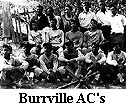
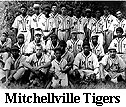
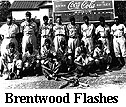
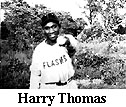
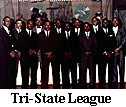
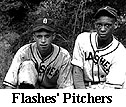
 Prince George's County:
Prince George's County:
 After studying American culture and history, a French observer
concluded, "whoever wants to know the heart and mind of America had
better learn baseball." The quote is even more meaningful when applied
to African American sandlot teams of the mid 20th century. Sandlot
baseball, named for the dusty fields on which it was often played, was
a foundation of African American community life across the country. It
provided recreation for local boys and men, entertainment for their fans
and a sense of shared purpose for all. In the Washington area, there
evolved a network of amateur teams, and Prince George's County was
home to several. Local teams such as the Brentwood Flashes, Lakeland
Giants and Glenarden Braves united communities, as families gathered
at ballfields all over the county to see their neighbors, friends and
relatives play. In the segregated Prince George's County of the 1930's,
'40's and '50's, sandlot ball took on a life of its own. Its importance is
evident in the comment of a former fan. When asked why seemingly
everyone was involved in the game he replied, "We didn't have anything
else."
After studying American culture and history, a French observer
concluded, "whoever wants to know the heart and mind of America had
better learn baseball." The quote is even more meaningful when applied
to African American sandlot teams of the mid 20th century. Sandlot
baseball, named for the dusty fields on which it was often played, was
a foundation of African American community life across the country. It
provided recreation for local boys and men, entertainment for their fans
and a sense of shared purpose for all. In the Washington area, there
evolved a network of amateur teams, and Prince George's County was
home to several. Local teams such as the Brentwood Flashes, Lakeland
Giants and Glenarden Braves united communities, as families gathered
at ballfields all over the county to see their neighbors, friends and
relatives play. In the segregated Prince George's County of the 1930's,
'40's and '50's, sandlot ball took on a life of its own. Its importance is
evident in the comment of a former fan. When asked why seemingly
everyone was involved in the game he replied, "We didn't have anything
else."Most often, games were played on summer Sundays, after church. Teams, traveling to the field in buses, cars or on foot, would meet each other for hours of serious play and fun. Sandlot teams were a source of pride, and their survival depended on community support. Money raised from events such as the "chitlin struts" routinely sponsored by supporters of Glenarden Braves helped to pay for uniforms, supplies and expenses. The teams played for free, and traveled at their own expense to face off against their neighbors next door or across the county.
Major League integration, which signaled the Negro Leagues7 demise, did little to inhibit the progress of sandlot ball. However, the 1957 formation of the Tri-State League changed the feel of sandlot ball in the county forever. The Tri-State League was a semi-professional league formed from some of the best sandlot and semi-professional teams in the area. Its charter members included the Washington Black Sox, Brandywine ACs, Glenarden Braves, Vista Yankees, Clinton Yellow Jackets, and from Charles County, the Pomonkey Browns and Bryantown Cardinals. To stay competitive, teams recruited players from the entire area, not just the neighborhood, and in so doing lost their distinctiveness. The better players joined Tri-State League teams for their share of semi-professional glory and a possible shot at the big leagues. Gradually, neighborhood teams disbanded, leaving community centers or other organizations to sponsor baseball. Later generations of athletes began to focus their attention on basketball, which could be played year round. Even the Tri-State league began to phase out in the late 1960's, although it survived in the 1980's. Nevertheless, neighborhood baseball is an important aspect of sports history, unifying communities and providing generations' worth of home grown heroes and mythic memories.






Black History Program
4302 Baltimore Avenue
Bladensburg, Maryland 20710
(301) 779-2011
